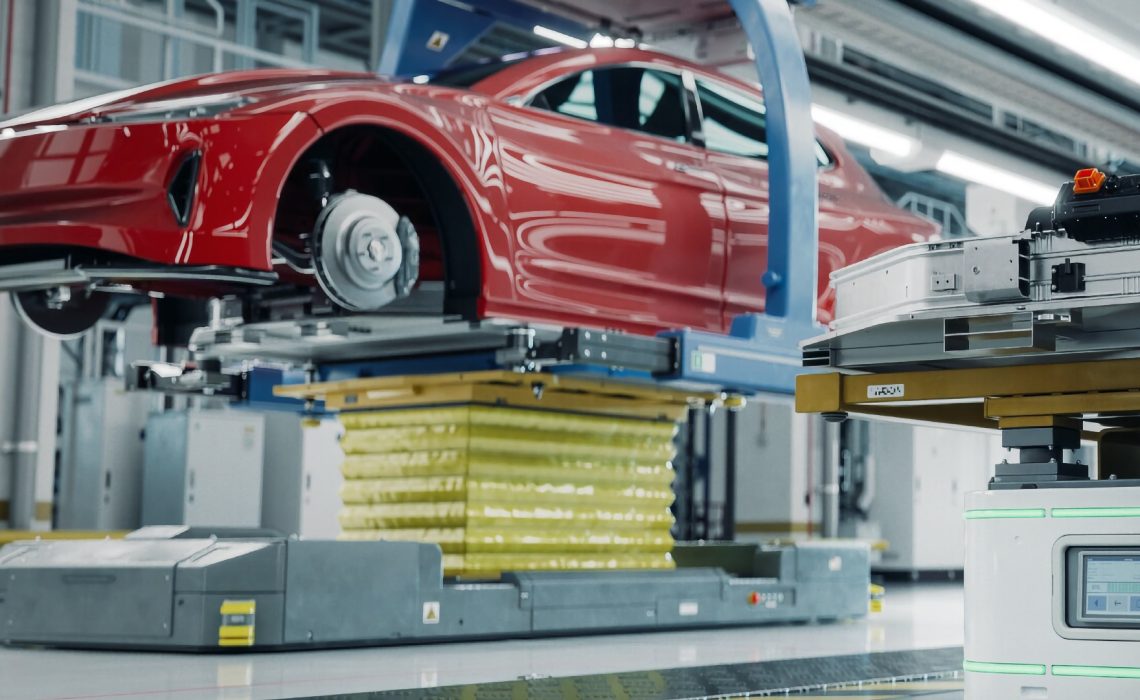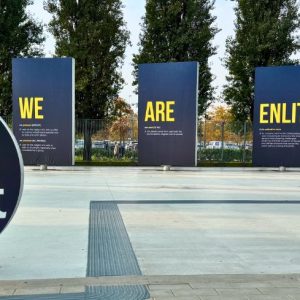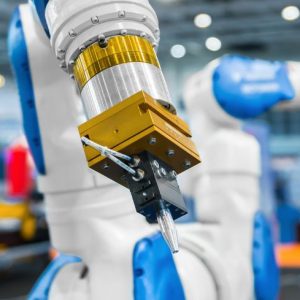Zonal platform. Domain architecture. Those are words people almost never hear in the context of the car they will drive in the next decade. When most people think of the future, they imagine an electric vehicle with a high level of driver assistance or autonomous driving capabilities – and all the latest digital media capabilities built in. While we might wonder what such a car would look like and how it would drive, we rarely think about what would need to take place in the unseen parts of the vehicle to make this reality. Yet, it’s exactly what is driving a hidden revolution: the move to zonal architecture and software-defined vehicles.
Let’s take a step back. A few years ago, most industry pundits foresaw the growing popularity of EVs (electric vehicles), and governments set ambitious goals, such as phasing out fossil fuel vehicles in the European Union by 2035. Many of these objectives are still in effect. And while some consumer adoption has slowed, the hype curve forecasts that the industry is about to pick up steam. Certain analysts simply think that consumers are waiting for longer-range, more reliable and extensive charging networks, as well as more affordable options.
Table of Contents
- Why is everyone talking about architecture? Understanding what’s unseen
- What is a car architecture and how has it evolved?
- What is a zonal architecture?
- Seeing what is hidden: the Q6 e-tron onboard network exhibit
- What are the innovations needed for the hidden revolution?
- The evolving role of semiconductor companies
Why is everyone talking about architecture? Understanding what’s unseen
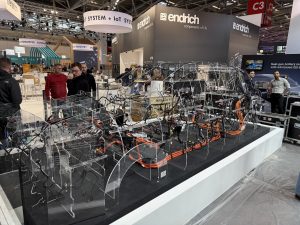
So why is the car of tomorrow not here already? Because building the kind of vehicles consumers are clamoring for requires the industry to rethink how cars are designed. OEMs, Tier 1 suppliers, and others have realized that one of their best solutions was to create new platforms to enable greater efficiency and more quickly introduce technological advancements. For instance, in May 2024, Audi revealed its Premium Platform Electric (PPE). Developed jointly with Porsche, the platform makes its Q6 e-tron series significantly more efficient and capable.
Yet, despite a renewed emphasis on the car architecture, almost no one ever gets to see this “platform.” It’s for this reason that the ST Booth at electronica 2024 in Munich, Germany, will give attendees the unique opportunity to see one of the most hidden aspects of modern vehicles: an electronic/electrical (E/E) architecture. The exhibit shows the wiring harness of an actual car currently on the market, peeling back the curtain to expose the quiet revolution happening in the automotive industry.
What is a car architecture and how has it evolved?
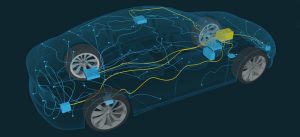
The first electronic system to make its way into mainstream vehicles was the electronic fuel injector (EFI) in the 70s, which replaced the carburetor. It used an Electronic Control Unit (ECU) to inject fuel into the engine, improving performance and reducing air pollution. As more ECUs brought electric windows or seats, for instance, engineers moved to a distributed architecture where one central gateway talked to multiple ECUs around the car. It enabled the prioritization of ECUs, ensuring that safety features, such as steering or braking, took precedence.
Afterward, as advanced driver assistance systems and new functionalities were invented and the industry maxed out the number of ECUs it could on a single platform, the industry moved to the domain architecture. This structure categorizes ECUs into domains, such as advanced driver-assistance systems (ADAS), powertrain, chassis, safety, infotainment, and more. Each domain has a gateway that talks to ECUs that control numerous devices and sensors. Many car makers have adopted this architecture today, for good reasons, optimizing it with each new iteration to make it more efficient. In the same vein, other car makers with the same goal in mind are exploring zonal architectures.
What is a zonal architecture?
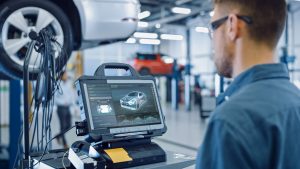
The zonal architecture organizes ECUs by their physical location inside the vehicle. It leverages a new generation of ECUs with powerful processing functions and a central High-Performance Computing Unit (HPCU) that supports fast communication protocols like Ethernet. Consequently, it simplifies platform design by reducing cable lengths and gauges, among other things. A central HPCU can also deal with the amount of data, computational throughput, and power required by high-performance ADAS functions, as well as new applications, such as AI.
This helps car makers move toward software-defined vehicles – an important step in speeding up innovation and allowing smartphone-like upgrades over time, thanks to over-the-air updates. This explains why S&P Global Mobility predicts that nearly 40% of the new cars manufactured in 2034 will feature a zonal architecture.
The Q6 e-tron onboard network exhibit on the ST booth at electronica is a great example of a car maker optimizing its architecture. The domain platform features 1,500 cables totaling over 3,500 meters (about 3,900 yards) and weighing nearly 60 kilograms (130 lb). It also includes over 400 connectors that can interconnect around 100 ECUs. It’s rare to see this harness laid out in public. The exhibit exemplifies the expertise it takes to ensure that all ECUs and connectors serve to optimize the platform rather than weighing it down. It’s a new way of thinking that demands highly specialized know-how and extensive knowledge of the overall product.
The move to a zonal architecture demonstrates this point even more. Conservatively, a vehicle switching to a zonal architecture would see its overall harness weight shrink by around 20%, increasing the battery’s range or gas mileage. A lighter car takes less energy to travel a set distance, thus improving its efficiency and reducing operating costs since consumers can drive more for less. Hence, it is fascinating that while the lighter and simpler harness is entirely hidden from the user, its impact is very visible.
Software is taking the wheel
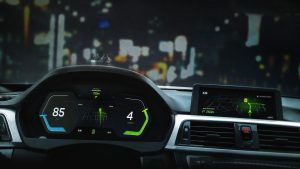
Another way the hidden architecture makes itself known to users is through the many software features consumers want to use and see improved throughout the life of their vehicle. Not many realize how applications govern cars, but they still demand features like 360º camera vision as well as connected and cloud-based systems that provide entertainment, over-the-air updates, and other smartphone-like capabilities. Most drivers don’t know that the harness is directly responsible for enabling a new generation of software-defined vehicles, but they expect predictive maintenance applications for a better experience. And car makers know that instead of a recall, a software update can help save a lot of time, significantly reduce costs, and improve brand appreciation.
Today, software increasingly controls every aspect of the car, thanks in part to the rise of real-time virtualization, which improves the use of hardware resources by ensuring developers can do more with the same components. It’s all about decoupling the code from what it runs on. Thanks to containers and hypervisors, it is possible to run multiple software modules on one hardware ecosystem and still enjoy proper segregation to protect against interference. The technology is already popular in servers and data centers to create secure, safe, and efficient systems. It’s no wonder car makers are bringing it to their new vehicles.
Another advantage of this software paradigm is that it is responsible for the explosion of data generation and the centralization of processing capabilities for improved analysis and decision-making. New architectures have enabled car makers to install hundreds of sensors when they were limited to a few dozen in previous platforms. And more importantly, thanks to the more powerful ECUs and HPCUs, OEMs can future-proof systems and run powerful algorithms but still enjoy a more straightforward development experience. If one software platform can run more applications, it will enable car makers to offer more and richer features while keeping costs down, and ensure consumers get more value out of their vehicles.
Hardware metamorphosis
As we alluded to, the advent of software-defined vehicles and the decoupling of the hardware from the application is only possible if car makers choose microcontrollers and microprocessors that can meet their safety requirements while also offering the computational power and hardware IPs necessary to make this a reality. Engineers must find devices that can support real-time virtualization, numerous I/Os, and a large, embedded, and fast memory that facilitates over-the-air updates. MCUs must be designed and certified for automotive use with specialized safe redundancy built-in, especially as ECUs handle more and more safety applications.
It’s easy to see that this new evolution in car architecture represents a unique electrical challenge, as engineers must create robust, safe, and efficient power distribution mechanisms. It’s the reason why many are adopting smart switches. Unlike the classic melting fuses and mechanical relays, these new electronic switches are faster. As a result, they can offer far greater protection against an adverse electrical event because they respond much quicker than classical components. Their electronic nature also makes them vastly more accurate and flexible. Indeed, they come with monitoring features to enable real-time load management and control. Moreover, they are resettable, which saves from having to replace them manually.
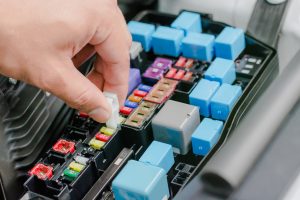
Another critical benefit of smart fuses is their tiny size compared to traditional switches and relays. Because eFuses are so small and electronically controlled, car makers can use shorter harnesses since, among other things, they no longer need to route cables to a large fuse box that must be user accessible. Moreover, the significantly higher accuracy means that the harness can be thinner, thus further contributing to weight reduction. A smaller design with fewer components that are more robust and accurate also helps improve overall reliability. Hence, while some engineers are still evaluating the cost of eFuses, the overall savings over the architecture’s lifetime explain their increasing popularity.
Taking a step back, we see that power distribution is also a much more critical engineering challenge because vehicles are dealing with far greater loads. Most architectures must handle 12 V, but the industry is moving to 48 V. EV chargers must also be able to handle very high voltages and power levels (up to 3,500 kW today). Hence, one of the most popular solutions is to use wide bandgap devices, such as silicon carbide (SiC). The fast switching frequencies of SiC MOSFETs and diodes mean they can handle a lot more power without the energy losses of previous devices, enabling smaller traction inverters, faster charging modules, and more efficient compressors, among other things.
The evolving role of semiconductor companies
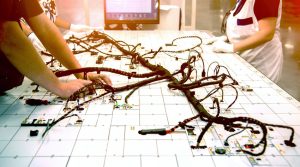
The domain and zonal car architectures emerging today testify to a new reality: everything is connected, and all roads (harnesses, in this case) lead to close cooperation between the key actors of the industry – car makers, Tier 1s, and semiconductor companies. Companies like ST understand how to support platform designers in their quest to decouple the hardware from the software and improve efficiency, safety, and robustness. Together, they create the innovations essential to the future of vehicles that will drive demand for the next generation of cars. It’s for this reason that existing carmakers and new startups are creating ever more intimate partnerships with semiconductor makers and why the market is going through such a disruption.
ST’s ability to grasp new engineering challenges is evidenced through its products. The Stellar family of devices has unique virtualization capabilities to future-proof the software-driven vehicles of tomorrow while its software ecosystem helps reduce development times and meet regulatory requirements. Similarly, STi²Fuse can shrink the overall harness, reduce the bill of materials, and optimize the overall power distribution. Additionally, silicon carbide power devices continue to bring new levels of efficiency. In essence, it’s by offering a wide range of solutions that semiconductor companies can be the close partners that car makers need them to be as they drive the new architectures that will meet the hopes and expectations of their customers.


